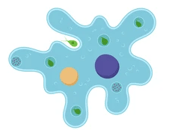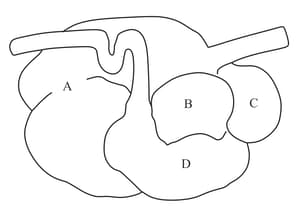Amoeba is a microscopic single-celled organism found in pond water. It pushes out one, or more finger-like projections, called pseudopodia or false feet for movement and capture of food. Amoeba feeds on some microscopic organisms. When it senses food, it pushes out pseudopodia around the food particle and engulfs it. The food becomes trapped in a food vacuole.

It is said food vacuole in Amoeba is similar to the small intestine of human beings. Do you agree? Explain.


Important Questions on Nutrition in Animals

The above diagram represents stomach of ruminants. Identify A,B, C and D. What will happen if A will not function properly in ruminants?

Organs and associated functions are given in options. Which of the following correctly states the function of the labelled organ?
When a person puts food in his mouth, then teeth cut it into small pieces, chew and grind it. The glands A in the mouth secrete a substance B which is mixed with the food by the tongue. The substance B contains an enzyme C which starts the digestion of food in the mouth. The slightly digested food from the mouth goes down a tube called oesophagus and subsequently passes through different organs and glands for the digestion process.
What is (i) gland A (ii) substance B, and (iii) enzyme C?
